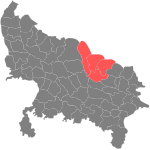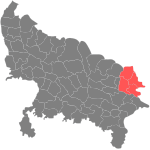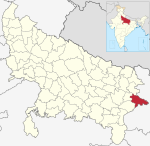Uttar Pradesh
Uttar Pradesh is literally known as ‘Northern Province’ and is located in Northern India. It shares its borders with many other states like Delhi, Rajasthan, Haryana, Uttarakhand and many more. The culture of the state has roots in its art, literature, history and traditions. The festivals celebrated in the state are Diwali, Dussehra, Ganesh Chaturthi, Eid, Buddha Jayanti and many more. The Kumbh mela organised in the state is visited by large number of tourists from across the country. Taj Mahal in Agra which is also one of the Seven Wonders of the World attracts tourists from all over the world. Be it Forts, monuments or pilgrimage centres Uttar Pradesh has a lot to offer to the tourists.
Uttar Pradesh (/ˌʊtər prəˈdɛʃ/;[11] Hindustani: [ˈʊtːəɾ pɾəˈdeːʃ] (![]() listen), lit. ‘Northern Province’) is a state in northern India. With over 200 million inhabitants, it is the most populous state in India as well as the most populous country subdivision in the world.[12] It was created on 1 April 1937 as the United Provinces of Agra and Oudh during British rule, and was renamed Uttar Pradesh in 1950, giving it the acronym UP. The state is divided into 18 divisions and 75 districts, with the state capital being Lucknow, and Allahabad serving as the judicial capital. On 9 November 2000, a new state, Uttaranchal (now Uttarakhand), was carved from the state’s Himalayan hill region. The two major rivers of the state, the Ganges and Yamuna, join at Triveni Sangam in Allahabad and flow further east as Ganges. Other prominent rivers are Gomti and Saryu. The forest cover in the state is 6.1% of the state’s geographical area. The cultivable area is 82% of total geographical area and net area sown is 68.5% of cultivable area.
listen), lit. ‘Northern Province’) is a state in northern India. With over 200 million inhabitants, it is the most populous state in India as well as the most populous country subdivision in the world.[12] It was created on 1 April 1937 as the United Provinces of Agra and Oudh during British rule, and was renamed Uttar Pradesh in 1950, giving it the acronym UP. The state is divided into 18 divisions and 75 districts, with the state capital being Lucknow, and Allahabad serving as the judicial capital. On 9 November 2000, a new state, Uttaranchal (now Uttarakhand), was carved from the state’s Himalayan hill region. The two major rivers of the state, the Ganges and Yamuna, join at Triveni Sangam in Allahabad and flow further east as Ganges. Other prominent rivers are Gomti and Saryu. The forest cover in the state is 6.1% of the state’s geographical area. The cultivable area is 82% of total geographical area and net area sown is 68.5% of cultivable area.
The state is bordered by Rajasthan to the west, Haryana, Himachal Pradesh and Delhi to the northwest, Uttarakhand and an international border with Nepal to the north, Bihar to the east, Madhya Pradesh to the south, and touches the states of Jharkhand and Chhattisgarh to the southeast. It covers 240,928 km2 (93,023 sq mi), equal to 7.3% of the total area of India, and is the fourth-largest Indian state by area.
List of districts of Uttar Pradesh
Uttar Pradesh is divided into 75 districts under these 18 divisions:[109]
Division wise listing of districts[edit]
Uttar Pradesh has more metropolitan cities than any other state in India.[113][114] The absolute urban population of the state is 44.4 million, which constitutes 11.8% of the total urban population of India, the second-highest of any state.[115] According to the 2011 census, there are 15 urban agglomerations with a population greater than 500,000.[116] There are 14 Municipal Corporations,[117][118] while Noida and Greater Noida in Gautam Budh Nagar district are specially administered by statutory authorities under the Uttar Pradesh Industrial Development Act, 1976.[119][120] | Area-wise listing of districts[edit]
| ||||||||||||||||||||||||||||||||||||||||||||||||||||||||||||||||||||||||||||||||||||||||||||||||||||||||||||||||||||||||||||||||||||||||||||||||||||||||||||||||||||||||||||||||||||||||||||||||||||||||||||||||||||||||||||||||||||||||||||||||||||||||||||||||||||||||||||||||||||||||||||||||||||||||||||||||||||||||||||||||||||||||||||||||||||||||||||||||||||||||||||||||||||||||||||||||||||||||||||||||||||||||||||||||||||||||||||||||||||||||||||||||||||||||||||||||||||||||||||||||||||||||||||||||||||||||||||||||||||||||||||||||||||||||||||||||||||||||||||||||||||||||||||||||||||||||||||||||||||||||||||||||||||||||||||||||||||||||||||||||||||||||||||||||||||||||||||||||||||||||||||||||
Demographics
Uttar Pradesh has a large population and a high population growth rate. From 1991 to 2001 its population increased by over 26%.[122] Uttar Pradesh is the most populous state in India, with 199,581,477 people on 1 March 2011.[123] The state contributes 16.2% of India’s population. The population density is 828 people per square kilometre, making it one of the most densely populated states in the country.[10] Uttar Pradesh has the largest scheduled caste population whereas scheduled tribes are less than 1 per cent of the total population.[124][125]
The sex ratio in 2011, at 912 women to 1000 men, was lower than the national figure of 943.[9] The state’s 2001–2011 decennial growth rate (including Uttrakhand) was 20.1%, higher than the national rate of 17.64%.[126][127] Uttar Pradesh has a large number of people living below the poverty line.[128] As per World Bank document (released on 2016), the pace of poverty reduction in the state has been slower than the rest of the country.[129] Estimates released by the Reserve Bank of India for the year 2011–12 revealed that Uttar Pradesh had 59 million people below the poverty line, the most for any state in India.[128][130] The central and eastern districts in particular have very high levels of poverty. The state is also experiencing widening consumption inequality. As per the report of the Ministry of Statistics and Programme Implementation (released on 7 January 2020), the state per capita income is below ₹8,000 (US$110) per annum.[131]
Transportation
he state has the largest railway network in the country but in relative terms has only sixth-highest railway density despite its plain topography and largest population. As of 2011, there were 8,546 km (5,310 mi) of rail in the state.[224] Allahabad is the headquarters of the North Central Railway[225] and Gorakhpur is the headquarters of the North Eastern Railway.[226][227] Other than Zonal Headquarters of Allahabad and Gorakhpur, Lucknow and Moradabad serve as divisional Headquarters of the Northern Railway Division. Lucknow Swarna Shatabdi Express, the second fastest shatabdi train, connects the Indian capital of New Delhi to Lucknow while Kanpur Shatabdi Express, connects New Delhi to Kanpur. This was the first train in India to get the new German LHB coaches.[228] The railway stations of Allahabad Junction, Agra Cantt, Lucknow NR, Gorakhpur Junction, Kanpur Central, Mathura Junction and Varanasi Junction are included in the Indian Railways list of 50 world-class railway stations.[229]




























































































